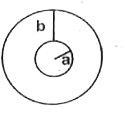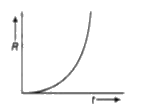A plarinum resistance thermometer is condtructed which resds ,00 at ice point and 1000 at steam point. Let tpde¬etemoeratureonthissca≤and≤ttde¬ethetemperatureonametcuryonamercurythemomentersca≤.Theresistanceoftheplat∈umcoilvareswithtasR_1 = R_0 (1+alphat + betat^2).DeriveanexpressionfortheresistanceasafunctionofT_p.
Let Rtp denote the residtance of the coil at the platinum scale temperature tp. Then
tp=RTp−R0R100−R0×100
or, Rtp=tp100(R100−R0)+R0
= t_p/100 [R_0 {1+alpha xx 100 + beta xx (100)^2} - R_0] + R_0<br>=tp100[α×100+β×(100)2]R0+R0
R_0 [ 1+ {1+{alpha xx 100 + beta xx (100)^2} t_p/100]<br>= R_0 [ 1+alphat_p + beta xx (100) t_p].<br>Onlyνmericalvaluesofalpha and beta are to be used.
Topper's Solved these Questions
- HEAT AND TEMPERATUREBOOK - HC VERMACHAPTER - HEAT AND TEMPERATUREEXERCISE - Short Answer
13 Videos
- HEAT AND TEMPERATUREBOOK - HC VERMACHAPTER - HEAT AND TEMPERATUREEXERCISE - Objective 1
12 Videos
- GRAVITATIONBOOK - HC VERMACHAPTER - GRAVITATIONEXERCISE - Exercises
39 Videos
- HEAT TRANSFERBOOK - HC VERMACHAPTER - HEAT TRANSFEREXERCISE - EXERCIESE
1 Videos
Similar Questions
A certain platinum resistance thermometer has a resistance of 90.35 ohms when its bulb is placed in a triple-point cell. What is the temperature on the platinum scale when its resistance is 96.28 ohms? What is the correct temperature on the Celsius and the thermodynamic scale if the resistance varies as R=R0(1+0.004t)?
View SolutionThe current in the inner coil is I=2t2. Find the heat developed in the outer coil between t =0 and t seconds. The resistance of the outer coil is R and take b>>a.

View Solution
Knowledge Check
The resistance t R of a conductor varies with temperature t as shown in the figure. If the variation is represented by Rt=R0[1+αt+βt2], then
 Aα and β are both negativeBα and β are both positiveCα is positive and β is negativeDα is negative and β are positive
Aα and β are both negativeBα and β are both positiveCα is positive and β is negativeDα is negative and β are positiveChoose the most appropriate option.
The resistance R of a conductor varies with temperature t as shown in figure. If the variation is represented by Rt=R0(1+αt+βt2).

ThenAαandβ bothe negativeBα is positive and β is negativeCαandβ both are positiveDα is negative and β is negativeThe charge flowing through a resistance R varies with time as Q=2t−8t2 . The total heat produced in the resistance is (for 0≤t≤18)
AR6 joulesBR3 joulesCR2 joulesDR joules
A resistance thermometer reads R=20.0Ω,27.5Ω,and50.0Ω at the point (0C), the steam point (100C) and the zinc point (420C) respectively.Assuming that the resistance varies with temperature as RΘ=(1+αΘ+βΘ2) , find the values of R0, alpha and beta. Here Theta represents the temperature on Celsius scale.
View SolutionA platinum resistancethermometer reads 00at the ice point and boiling point of water respectively. The resistance of a platnum wire varies with Celsius temperature θ as Rt=R0(1+αθ+βθ2), where α=3.8×10−3^0C−1 and β=−5.6×10−7^0C−2. What will be the reading of this thermometer if it is pleaced in a liquid bath maintained at 500C?
View SolutionThe resistance of a certain platinum resistsance thermometer is fouond to the 2.56 ohms at 0∘C,2.56 ohms at 100∘C and 6.78 ohms at 444.6∘C (the boiling point of sulphur on the perfect gas scales). Calculate the temperature of the bath in which the platinum resistance is 5.06 ohms.
View SolutionThe resistances of a platinum resistance thermometer at the ice point, the steam point and the boiling point of sulphur are 2.50,3.50and6.50Ω respectively. Find the boiling point of sulphur on the platinum scale. The ice point and the steam point measure 00and1000 respectiely.
View SolutionResistance of a resistor at temperature t∘CisRt=R0(1+αt+βt2), where R0 is the resistance at 0∘C. The temperature coefficient of resistance at temperature t∘C is
View Solution
